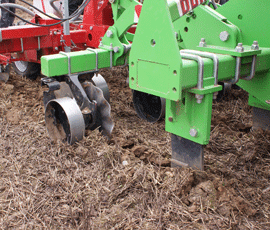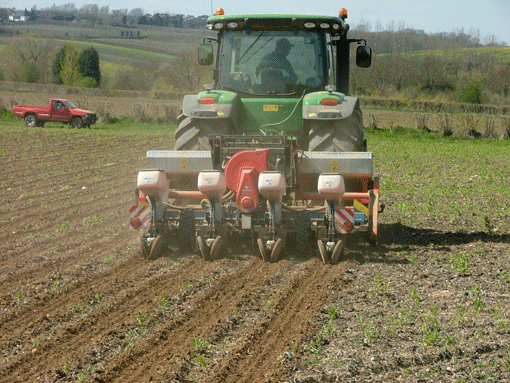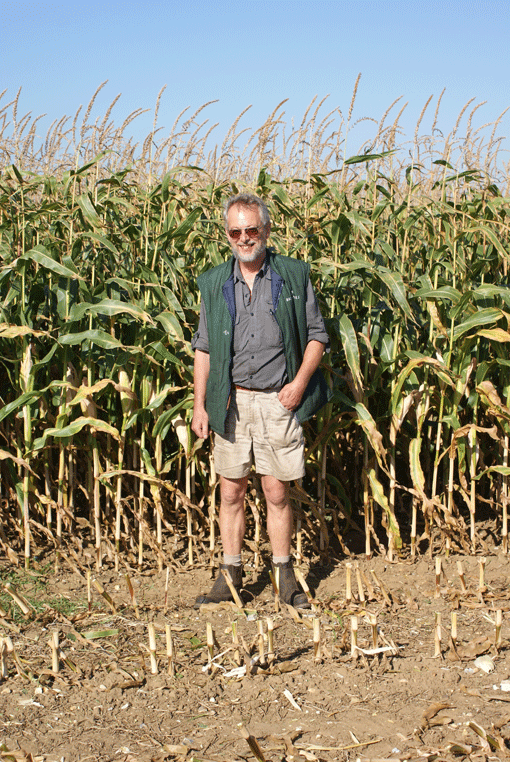Strip tillage proves ideal for establishing maize

The number of strip tillage units on UK farms could probably be counted on the fingers of one hand, but in Europe the technique has at least 25 year’s history for establishing forage maize and other crops with widely-spaced rows including oilseed rape.
As the name suggests, strip tillage involves cultivating narrow strips of soil where seed is drilled, leaving ground between the strips undisturbed. The strips are prepared by a one-pass till-and-drill combination based on a special cultivator plus standard precision drill units. The machine usually works directly in stubble, sprayed-off grass or following a cover crop.
Trials on the continent show yields from forage maize crops grown with strip tillage are generally similar to those from conventionally established crops, but the farmers we spoke to are enthusiastic about the benefits.
Case study 1: Strip Tillage Pioneers in Kent
Jerry Wilson was probably the first farmer in Britain to use strip tillage commercially, an interest that started 10 years ago when he was involved in pilot trials with the Maize Growers’ Association (MGA). He travelled to Switzerland to visit the Althaus factory where the OekoSem strip tillage cultivator is made and visited farmers and contractors who were using it.
He was so impressed that he used a second-hand machine that had been imported for the MGA trials to establish some of the forage maize for the 80-cow Holstein Friesian dairy herd and 60 to 80 young stock and beef cattle on his Ottinge Court Farm at Ottinge, Hythe.
It was used with four Monosem precision seeders for part of his 14ha (35-acre) crop, with the rest established conventionally. The results convinced him to switch completely to strip tillage for maize and the old machine was replaced by a new, updated OekoSem 3 cultivator.
 |
|---|
Jerry Wilson has switched completely to strip tillage for maize. |
The Althaus OekoSem is a four-row machine based on a rotary cultivator with L-shaped blades cultivating the strips where precision seeders sow the seed. The blades cut 30cm strips to a depth of 10cm with tines subsoiling at up to 25cm under the strips. With rows spaced at 76cm this leaves more than two-thirds of the surface area uncultivated.
Mustard cover crop
Mr Wilson’s maize usually follows a mustard cover crop direct-drilled into winter wheat stubble following an application of manure from the farm’s weeping wall slurry store. Mustard builds up organic matter in his chalk-based soil and also reduces the risk of soil erosion. From mid-April onwards the cover crop is sprayed with glyphosate before the one-pass unit moves in to cultivate the strips, drill the maize and apply fertiliser in the strips.
The sprayer moves in again later with post-emergence herbicide and more fertilizer is applied using a converted Tive Aero-Spreader to place granules beside the crop rows.
“The benefits of strip tillage include reduced tractor activity and improved soil structure,” says Jerry Wilson. “Over the years we have seen increased earthworm activity and the power consumption for cultivations is reduced, which means less fuel is used. There is also far less damage caused by the harvester and trailers if strip-tilled maize is harvested in wet conditions.
“A few years ago at a demonstration comparing conventionally grown and strip tilled maize crops in Germany, heavy rain left puddles on the surface where the ground had been ploughed and cultivated, but there was no surface water on strip-tilled areas,” he says.
“Another benefit is reduced moisture loss because the soil is not cultivated before strip-tilling, but this also means the soil takes longer to warm up and strip-tilled maize should be drilled slightly later than conventionally grown crops.
“In a normal year maize yields from strip tillage are similar to conventional cultivations, but the strip-tilled crop will do better in a dry year because soil moisture is retained, and in a wet year it can outyield conventional systems because of the improved soil structure.”
Contracting
Although Jerry Wilson owns the OekoSem 3 strip tillage unit, it is operated by the contractor who does the arable and harvesting work on his 83ha (205-acre) farm. Chris Reynolds, the contractor, also maintains the machine and uses it in his contracting business.
Strip tillage contracting began when other farmers saw the Ottinge results, and it continues to increase, reaching almost 245ha (600 acres) of maize. Last year, with demand outstripping the capacity of Jerry Wilson’s machine, Mr Reynolds imported the latest four-row OekoSem 4 cultivator and added Monosem seeders, and he now uses both units.
The contracting business is based at the 200ha (495 acres) Pent Farm, Postling, Hythe where Mr Reynolds is farms director for S Salbstein Ltd, and he also contract farms an adjoining 345ha (852 acres) growing cereals for seed, plus rape and pulses. He uses a 160hp tractor on Jerry Wilson’s OekoSem 3 and his own OekoSem 4 is powered by a 270hp tractor. Typical output per machine is about 10ha a day.
“For strip tilling maize the contract charge is £150 to £170 a hectare depending on the abrasiveness,” said Mr Reynolds. “Blade wear can be a major cost item and we use durafaced blades for a longer working life.
“Our customers cover a wide range of soils from brick earth to heavy clay as well as Jerry’s chalky soil, and the results have been very good. I think the only concern is that strip-tilled maize appears to make a slow start, but growth compensates later and yields are similar to conventionally grown maize.
“Strip tilling with the OekoSem is versatile and I think demand will continue to increase.”
Case Study 2: First Year Success in Norfolk
Forage maize at Stephen Temple’s Copys Green Farm provides feed for the farm’s 100-cow dairy herd plus young stock and helps produce methane from a digester for generating electricity.
As well as some of the maize, the digester also uses manure plus whey from the farmhouse cheese production. It also supplies the 230ha (568 acres) farm’s electricity needs, including heat for grain drying, with the surplus sold to the Grid.
This year’s forage maize crop totalled 62ha (153 acres), most of it established with strip tillage. This follows a visit to France last year where Stephen Temple and his wife, Catherine, who runs their cheese making business, looked at strip-tilled maize and rape crops.
Impressed by what they saw, the Temples ordered a Duro-France strip tillage cultivator, which uses deep working tines plus discs to prepare 6cm wide strips at 75cm centres. The cultivator is available for up to eight rows, but a four-row version with 3.0m working width is used at the Temples’ farm at Wighton, Fakenham where it works with four Kongskilde precision seeder units. Minimum recommended tractor size is 120hp, but Stephen Temple uses a 200hp tractor to ensure ample lift capacity.
Dr Temple, who does his own harvesting with a trailed JF machine, says the maize yields were what he would normally expect, but the switch to strip tillage produced a number of benefits.
 |
|---|
Dr Stephen Temple has found he’s saved time and fuel with a one-pass crop establishment. |
One advantage that showed up this year was the saving in time and fuel achieved by the one-pass crop establishment. The workrate for strip-tilling into stubble on their sandy loam soil is about 10ha in a nine-hour day or about the same as one pass with a power harrow in a conventional plough and cultivate sequence.
Fuel consumption was estimated at 12.5-15 l/ha, less than half the fuel needed for a conventional cultivation sequence, and avoiding the need to replace the plough and power harrow parts also trimmed costs.
Conserving soil moisture through leaving most of the surface undisturbed should be a major benefit in a dry summer, he says, and reducing the risk of erosion by blowing or surface run-off were also high on Stephen Temple’s aims. But one unexpected benefit that emerged during this year’s maize harvest was the lack of weed growth.
“This year’s crops are extremely clean, and I think this is because only a very small area of soil is cultivated with strip tillage, which means fewer weed seeds are buried,” he says.ysys. “The lack of weeds is a major bonus.”

